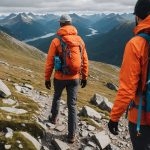Understanding Weather Conditions for Mountain Hiking
When embarking on a mountain hiking adventure, understanding the weather conditions for hiking is crucial for a safe and enjoyable experience. Mountain environments are known for their fluctuating weather patterns, with varying temperatures, levels of precipitation, and wind conditions all influencing the hiking journey. These factors not only impact the experience but also dictate the type of gear required.
Temperature plays a significant role in gear selection, as it affects the body’s thermal comfort. Layers are essential, with base layers providing moisture management, while insulation layers keep warmth locked in during colder hikes. Precipitation necessitates waterproof gear to ensure dryness, thereby preventing hypothermia, while wind-resistant materials offer protection against harsh winds.
Also to read : Discover the Perfect Eye Cream for You: Tailored Skincare Solutions for Every Skin Type
Sudden weather changes are a common occurrence in mountainous areas, making preparation vital. Checking weather forecasts and packing accordingly can mitigate these risks. Choosing the right gear in advance prepares you for such unpredictable conditions and ensures safety and comfort. Understanding and anticipating the mountain hiking weather can transform a potentially challenging trek into a seamless and memorable journey.
Essential Hiking Gear Categories
Mountain hiking demands a strategic approach to hiking gear categories selection, ensuring that you are equipped for diverse weather conditions. Each category serves a particular purpose in providing comfort, safety, and efficiency on your hike.
Also to discover : Definitive Heat Styling Guide: Essential Methods to Shield Curly Hair with Thermal Protection
Clothing
Selecting appropriate clothing is vital. Begin with base layers that offer moisture management, essential for maintaining comfort during physical activity. Insulation layers provide warmth against colder mountain temperatures, while outer layers serve as a shield against elements like wind and rain. Each layer plays a role in adapting to changing weather conditions during your hiking journey.
Footwear
Footwear is another key aspect of types of hiking equipment. Opt for hiking boots or shoes suited to different terrains; their design impacts traction and stability. For wet conditions, consider waterproof designs, while breathable options can be more comfortable in dry conditions. The choice will significantly influence your ability to comfortably traverse mountain paths.
Accessories
Accessories enhance overall hiking efficiency. A reliable backpack with a hydration system ensures that all essentials, including water, are conveniently portable. Navigational tools like maps and compasses provide safety, while other functional accessories, such as trekking poles, can offer support on uneven terrain. By selecting the right personal items, you ensure comfort and preparedness for your hike.
Material Specifications and Performance
The choice of hiking gear materials is pivotal in ensuring comfort and durability during mountain expeditions. By understanding the fabric properties, hikers can better navigate varied weather conditions. Performance fabrics such as moisture-wicking materials are particularly valuable, as they swiftly draw sweat away from the skin, promoting dryness and reducing the risk of chafing. Additionally, materials with thermal regulating features help maintain body temperature in fluctuating climates, providing warmth when it’s cold and cooling when it’s hot.
Durability is another critical factor when selecting hiking gear, as rugged terrains demand robust construction. Materials like high-denier nylon and polyester are often favoured for their strength and resistance to wear and tear, ensuring that gear withstands the demands of the trails.
Maintenance is essential for long-lasting gear. Following care instructions, such as washing at appropriate temperatures and using mild detergents, can extend the lifespan of essential hiking items. By investing in high-quality materials and committing to regular maintenance, hikers can enjoy reliable gear that enhances their trail experiences myriad times over, ensuring enduring adventures.
Gear Recommendations for Specific Weather Scenarios
Navigating diverse mountain conditions requires tailored hiking gear recommendations to ensure comfort and safety.
Hot Weather
For warmer climates, opt for lightweight gear options designed to facilitate breathability. Integrating cooling technologies within apparel can make an immense difference, allowing airflow and reducing overheating. Remember, an effective hydration strategy is essential: consider backpacks with hydration systems for easy access to water.
Cold Weather
Insulation is key in frigid settings. Equip yourself with insulated clothing and gear that retains body heat. Layering is paramount—combine base, insulating, and outer layers to trap warmth while allowing flexibility in changing conditions. Footwear should be winter-appropriate, providing both warmth and grip on icy terrains.
Rainy and Windy Conditions
When facing wetter climates, rely on waterproof materials and technologies to keep dry. Select gear featuring sealed seams and breathable membranes. For wind, windproof gear specifications like tightly woven fabrics are advantageous. Furthermore, consider protective accessories such as hats and gloves to shield against elements and stay comfortable amidst unpredictable weather shifts.
Gear Comparison and Reviews
When selecting the best hiking gear, analysis of hiking gear reviews is essential to understand product capabilities. Exploring leading brands offering reliability and innovation is a good starting point. Companies like The North Face, Patagonia, and Columbia are renowned for durable, high-performance products, boasting advanced performance fabrics and impressive versatility.
Product comparisons help assess your options. For instance, jackets designed with Gore-Tex offer exceptional breathability and waterproofing, suitable for varied weather conditions. By comparing these against REI’s own H2No technology, you evaluate how they stack up in terms of weather conditions for hiking, cost, and durability.
User reviews and insights bring additional value. They provide real-world feedback on hiking gear, highlighting critical performance aspects in mountain environments. Reviews often draw attention to features like ease of use and packability, allowing hikers to make informed choices. Users’ experiences showcase gear strengths and areas for improvement, ensuring alignment with specific hiking needs.
Such product evaluations provide a platform for strategic selection, empowering hikers to confidently choose gear that meets their precise demands and enhances their mountain excursions.
Checklist for Essential Mountain Hiking Gear
Creating an effective hiking gear checklist is vital for preparedness, ensuring all essential equipment is considered. When compiling your list, tailor it to varying weather conditions and your specific trail plans. This customised approach allows you to anticipate the unique demands of each excursion.
A typical checklist should include multi-layer clothing that adapts to fluctuating temperatures – with moisture-wicking base layers, thermal insulation, and weatherproof outerwear as staples. Footwear designed for terrain is essential, focusing on durable hiking shoes or boots with adequate grip and comfort.
Personalizing the checklist is crucial for aligning it with your hiking trip goals. For instance, if you’re venturing on a longer hike, you might include additional nutrition and hydration strategies, using backpacks with built-in hydration systems for hands-free water access. Safety equipment, such as navigational tools and first-aid kits, underpin a secure hiking experience.
Finally, emphasize periodic gear assessment and updates, which allow you to replace worn-out items and integrate new technologies that can enhance performance and safety. Staying mindful of gear condition and appropriateness helps ensure your ventures are both enjoyable and secure.











